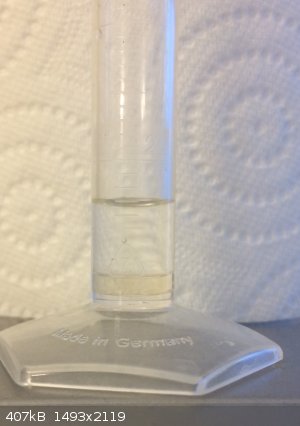Keras
National Hazard
   
Posts: 931
Registered: 20-8-2018
Location: (48, 2)
Member Is Online
|
|
What is the yield of a typical haloform reaction?
With the ongoing lockdown, I tried to perform a microscale haloform reaction, with 60 ml of 3.7% bleach (30 mmol) and 2 ml of acetone (25 mmol, a
large excess on stoichiometry). Adding the acetone to a freezing (0°C) solution of NaOH and bleach gave me a final 0.4 ml of chloroform, or 5 mmol,
which seems to be a 50% yield on bleach.
Knowing that chloroform solubility in water is around 8 g/L, the 60 ml of supernatant water should contain about 0.5 g of chloroform (0.3 ml) so the
total yield is 1.09 g, or 9.2 mmol, which is pretty much quantitative.
I'm curious: what is the yield on a larger scale?

|
|
|
Fery
International Hazard
    
Posts: 1026
Registered: 27-8-2019
Location: Czechoslovakia
Member Is Offline
|
|
you can perform steam distillation (just simple distillation, no need to add any source of steam) of the water layer and the distillate will be
enriched in chcl3 so more of the product will separate
|
|
|
NaK
Hazard to Self
 
Posts: 83
Registered: 12-9-2019
Member Is Offline
|
|
well yields pretty much are quantative but cooling and mixing is getting a lot harder on larger scale so you will lose a lot of NaOCl to thermal
decomposition if you can't keep up. And extracting from water is not practical either especially when the low price of the starting material is
considered.
Yield ranges pretty much between 50 and 70 % depending on bleach concentration (how much chloroform is lost to the residual water) and how well you
can control temperature and mixing
[Edited on 15-4-2020 by NaK]
[Edited on 15-4-2020 by NaK]
|
|
|
Boffis
International Hazard
    
Posts: 1879
Registered: 1-5-2011
Member Is Offline
Mood: No Mood
|
|
You can also add salt to the aqueous distillate or the original liquor to reduce losses into the aqueous layer.
|
|
|
Keras
National Hazard
   
Posts: 931
Registered: 20-8-2018
Location: (48, 2)
Member Is Online
|
|
Quote: Originally posted by Boffis  | | You can also add salt to the aqueous distillate or the original liquor to reduce losses into the aqueous layer. |
Thanks for all your answers. Yeah, I thought about salt, too. I tried that on a previous run, but I added to much of it and it was a pain to separate
the salt from the chloroform with a simple plastic Pasteur pipette.
TBH, I was not that obsessed about yield or anything, it was more to kill time than to do anything useful with the chloroform thus produced. But I was
surprised to get such a good yield. Now I will use the chloroform to clean a few spots…
Thanks again!
|
|
|
monolithic
Hazard to Others
  
Posts: 436
Registered: 5-3-2018
Member Is Offline
Mood: No Mood
|
|
I run the reaction on a 1 gallon of bleach scale. Molar yields are typically 75% on sodium hypochlorite (assuming the stated concentration on the MSDS
is accurate.)
|
|
|
UC235
National Hazard
   
Posts: 565
Registered: 28-12-2014
Member Is Offline
Mood: No Mood
|
|
You should be using an excess of bleach unless you really want traces of haloacetones left over and a chloroform-acetone azeotrope to try to break. I
would probably include a sulfuric acid wash and distillation before using it for anything sensitive to contaminants.
[Edited on 17-4-2020 by UC235]
|
|
|
monolithic
Hazard to Others
  
Posts: 436
Registered: 5-3-2018
Member Is Offline
Mood: No Mood
|
|
Quote: Originally posted by UC235  | You should be using an excess of bleach unless you really want traces of haloacetones left over and a chloroform-acetone azeotrope to try to break. I
would probably include a sulfuric acid wash and distillation before using it for anything sensitive to contaminants.
[Edited on 17-4-2020 by UC235] |
Can't you just wash it with brine? Chloforom is soluble in water ~8 g chloroform / 1000 ml water, probably less in brine.
|
|
|
morganbw
National Hazard
   
Posts: 561
Registered: 23-11-2014
Member Is Offline
Mood: No Mood
|
|
Quote: Originally posted by UC235  | You should be using an excess of bleach unless you really want traces of haloacetones left over and a chloroform-acetone azeotrope to try to break. I
would probably include a sulfuric acid wash and distillation before using it for anything sensitive to contaminants.
[Edited on 17-4-2020 by UC235] |
I think that one of our moderators was surprised by the amount of acetone in his chloroform when he tested it at his college.
|
|
|